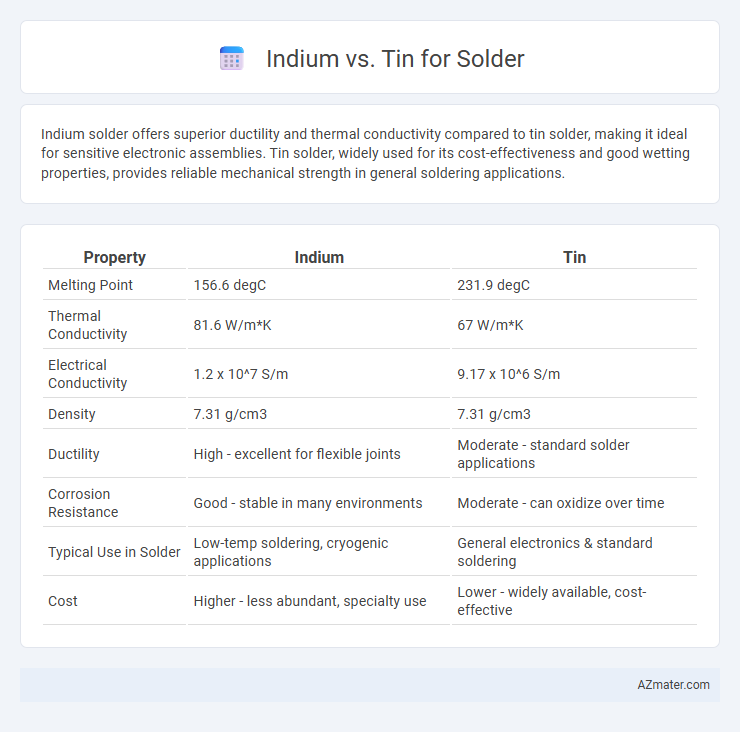Indium solder offers superior ductility and thermal conductivity compared to tin solder, making it ideal for sensitive electronic assemblies. Tin solder, widely used for its cost-effectiveness and good wetting properties, provides reliable mechanical strength in general soldering applications.
Table of Comparison
| Property | Indium | Tin |
|---|---|---|
| Melting Point | 156.6 degC | 231.9 degC |
| Thermal Conductivity | 81.6 W/m*K | 67 W/m*K |
| Electrical Conductivity | 1.2 x 10^7 S/m | 9.17 x 10^6 S/m |
| Density | 7.31 g/cm3 | 7.31 g/cm3 |
| Ductility | High - excellent for flexible joints | Moderate - standard solder applications |
| Corrosion Resistance | Good - stable in many environments | Moderate - can oxidize over time |
| Typical Use in Solder | Low-temp soldering, cryogenic applications | General electronics & standard soldering |
| Cost | Higher - less abundant, specialty use | Lower - widely available, cost-effective |
Introduction to Indium and Tin Solders
Indium and tin solders are widely used in electronics for their distinct melting points and reliability in various applications. Indium solder offers excellent thermal conductivity and ductility, making it ideal for delicate components and cryogenic environments, while tin solder is favored for its affordability, ease of use, and strong mechanical bonds in standard electronic assembly. Understanding the properties of indium and tin solders helps optimize performance in industrial and high-precision soldering tasks.
Chemical and Physical Properties Comparison
Indium exhibits a melting point of 156.6degC, significantly lower than tin's 231.9degC, making it ideal for low-temperature soldering applications. Chemically, indium is more resistant to oxidation, enhancing joint reliability and longevity compared to tin, which readily forms oxide layers that may hinder solder flow. Physically, indium's high ductility and softness allow better stress absorption in solder joints, whereas tin's brittleness can lead to increased susceptibility to fatigue and cracking under mechanical stress.
Melting Points and Temperature Requirements
Indium solder has a melting point of approximately 156.6degC, significantly lower than tin solder, which melts around 232degC, making indium ideal for temperature-sensitive electronics and substrates. The lower melting temperature of indium reduces thermal stress during the soldering process, preserving delicate components and preventing heat damage. Tin, commonly alloyed with lead or silver, is preferred for higher-temperature applications due to its stronger mechanical properties and higher melting threshold.
Electrical Conductivity Differences
Indium exhibits higher electrical conductivity than tin, making it advantageous for applications requiring efficient electron flow in solder joints. Indium's conductivity is approximately 15.6 x 10^6 S/m, compared to tin's 9.1 x 10^6 S/m, which translates to lower resistance and improved signal integrity. This difference is critical in high-performance electronics where minimizing power loss and heat generation is essential for device reliability.
Mechanical Strength and Flexibility
Indium solder exhibits superior mechanical strength and flexibility compared to tin solder, making it ideal for applications requiring high durability and resistance to thermal cycling. Indium's low modulus of elasticity allows it to absorb stress without cracking, whereas tin solder tends to be more brittle under mechanical strain. This makes indium-based solder joints highly reliable in electronic assemblies subjected to vibration and temperature fluctuations.
Oxidation Resistance and Long-Term Reliability
Indium solder exhibits superior oxidation resistance compared to tin, forming a stable oxide layer that prevents further corrosion and maintains joint integrity. Tin solder, while widely used, is more prone to oxidation, which can lead to reduced electrical conductivity and potential joint failure over time. For long-term reliability, indium's enhanced resistance to thermal cycling and oxidation makes it ideal for critical applications requiring durable and dependable solder joints.
Compatibility with Different Substrates
Indium solder offers superior compatibility with a wide range of substrates including ceramics, glass, and semiconductors due to its low melting point and ductility, which reduces thermal stress during bonding. Tin solder excels in joining metals such as copper, nickel, and plated surfaces, benefiting from its strong wetting properties and established use in electronics manufacturing. For applications requiring reliable adhesion to diverse materials, indium provides enhanced flexibility, while tin remains the preferred choice for standard metallic assemblies.
Environmental and Health Considerations
Indium solder offers lower toxicity compared to tin-lead alternatives, reducing health risks during soldering processes. Indium's environmental impact is minimized due to its non-toxic nature and better recyclability, whereas tin mining and refining can contribute to habitat degradation and heavy metal contamination. Selecting indium-based solder supports safer workplace conditions and aligns with stricter environmental regulations on hazardous substances.
Cost and Availability Analysis
Indium solder commands a significantly higher price due to its rarity and limited mining sources, making it less economical for large-scale applications compared to tin. Tin, widely abundant and primarily sourced from large global producers like China and Indonesia, remains the cost-effective choice for most soldering needs. Availability constraints and price volatility of indium often restrict its use to specialized electronics requiring superior thermal and mechanical properties.
Applications: Which Solder for Which Purpose?
Indium solder excels in applications requiring low-temperature bonding, such as sensitive electronics and thermal interfaces, due to its excellent malleability and corrosion resistance. Tin solder, commonly used in electronics manufacturing, offers strong mechanical strength and reliable electrical conductivity for circuit board assembly and general-purpose soldering. Choosing between indium and tin solder depends on factors like operating temperature, thermal expansion compatibility, and environmental conditions specific to the application.

Infographic: Indium vs Tin for Solder
 azmater.com
azmater.com